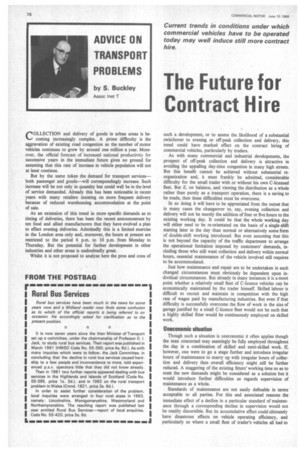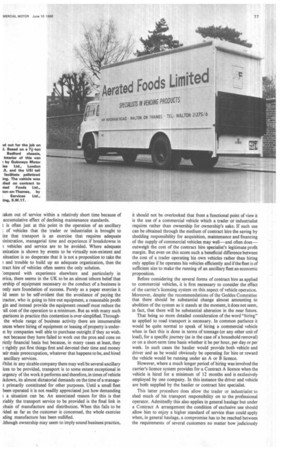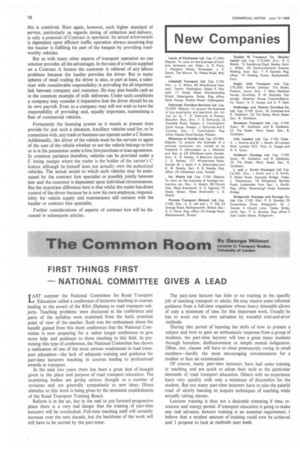The Future for Contract Hire
Page 78

Page 79

Page 80

If you've noticed an error in this article please click here to report it so we can fix it.
COLLECTION and delivery of goods in urban areas is becoming increasingly complex. A prime difficulty is the aggravation of existing road congestion as the number of motor vehicles continues to grow by around one million a year. Moreover, the official forecast of increased national productivity for successive years in the immediate future gives no ground for assuming that this rate of increase in vehicle population will not at least continue.
But by the same token the demand for transport services— both passenger and goods—will correspondingly increase. Such increase will be not only in quantity but could well be in the level of service demanded. Already this has been noticeable in recent years with many retailers insisting on more frequent delivery because of reduced warehousing accommodation at the point of sale.
As an extension of this trend in more specific demands as to timing of deliveries, there has been the recent announcement by ten food and allied manufacturers that they have evolved a plan to effect evening deliveries. Admittedly this is a limited exercise in the London area only and, moreover, the hours at present are restricted to the period 6 p.m. to 10 p.m. from Monday to Thursday. But the potential for further development in other industries and other areas is undoubtedly great_ Whilst it is not proposed to analyse here the pros and cons of such a development, or to assess the likelihood of a substantial switchover to evening or off-peak collection and delivery, this trend could have marked effect on the contract hiring of commercial vehicles, particularly by traders.
As with many commercial and industrial developments, the prospect of off-peak collection and delivery is attractive in avoiding the appalling day-time congestion in many high streets. But this benefit cannot be achieved without substantial reorganization and, it must frankly be admitted, considerable difficulty for the small trader with or without his own C-licensed fleet. But if, on balance, and viewing the distribution as a whole rather than purely as a transport operation, there is a saving to be made, then these difficulties must be overcome.
In so doing it will have to be appreciated from the outset that in many cases the changeover to, say, evening collection and delivery will not be merely the addition of four or five hours to the existing working day. It could be that the whole working day will either need to be re-orientated on the basis of a single shift starting later in the day than normal or alternatively some form of double-shift working introduced. But even assuming that this is not beyond the capacity of the traffic department to arrange the operational limitation imposed by customers' demands, including those who still want collection and delivery within normal hours, essential maintenance of the vehicle involved still requires to be accommodated.
Just how maintenance and repair are to be undertaken in such changed circumstances must obviously be dependent upon individual circumstances. But already in many instances it is a moot point whether a relatively small fleet of C-licence vehicles can be economically maintained by the trader himself. Skilled labour is difficult to recruit and maintain in competition with the high rate of wages paid by manufacturing industries. But even if that difficulty is successfully overcome the flow of work in the size of garage justified by a small C-licence fleet would not be such that a highly skilled fitter would be continuously employed on skilled work.
Uneconomic situation
Though such a situation is uneconomic it often applies though the man concerned may seemingly be fully employed throughout the day in a combination of skilled and semi-skilled work. If, however, one were to go a stage further and introduce irregular hours of maintenance to marry up with irregular hours of collection and delivery then overall efficiency might still be further reduced. A staggering of the existing fitters' working time so as to meet the new demands might be considered as a solution but it would introduce further difficulties as regards supervision of maintenance as a whole.
Standards of maintenance are not easily definable in terms acceptable to all parties. For this and associated reasons the immediate effect of a decline in a particular standard of maintenance through a corresponding decline in supervision would not be readily discernible. But its accumulative effect could ultimately have disastrous effects on vehicle operating efficiency, and particularly so where a small fleet of trader's vehicles all had to taken out of service within a relatively short time because of accumulative effect of declining maintenance standards.
t is often just at this point in the operation of an ancillary . of vehicles that the trader or industrialist is brought to ize that transport is an exercise that requires adequate iinistration, managerial time and experience if breakdowns in vehicles and service are to be avoided. Where adequate inization is shown by events to be virtually non-existent and situation is so desperate that it is not a proposition to take the and trouble to build up an adequate organization, then the tract hire of vehicles often seems the only solution.
!ompared with experience elsewhere and particularly in erica, there seems in the UK to be an almost inborn belief that .ership of equipment necessary to the conduct of a business is only sure foundation of success. Purely as a paper exercise it Id seem to be self-evident that the avoidance of paying the tractor, who is going to hire out equipment, a reasonable profit gin and instead provide the equipment oneself must reduce the -all cost of the operation to a minimum. But as with many such Iparisons in practice this contention is over-simplified. Throughthe whole range of business activity there are innumerable inces where hiring of equipment or leasing of property is underti by companies well able to purchase outright if they so wish. not because they have failed to work out the pros and cons on rictly financial basis but because, in many cases at least, they .t rightly put first things first and devoted their time and money leir main preoccupation, whatever that happens to be, and hired ancillary services.
Vhilst in any sizable company there may well be several ancillary ices to be provided, transport is to some extent exceptional in urgency of the work it performs and therefore, in times of vehicle idown, its almost dictatorial demands on the time of a managet primarily constituted for other purposes. Until a small fleet been operated it is not readily appreciated just how demanding
a situation can be. An associated reason for this is that riably the transport service to be provided is the final link in chain of manufacture and distribution. When this fails to be ,ided as far as the customer is concerned, the whole exercise Kling manufacture has been nullified.
.1though ownership may seem to imply sound business practice, it should not be overlooked that from a functional point of view it is the use of a commercial vehicle which a trader or industrialist requires rather than ownership for ownership's sake. If such use can be obtained through the medium of contract hire the saving by shedding responsibility for acquisition, maintenance and financing of the supply of commercial vehicles may well—and often does— outweigh the cost of the contract hire specialist's legitimate profit margin. But even on this score such a beneficial difference between the cost of a trader operating his own vehicles rather than hiring only applies if he operates his vehicles efficiently and if the fleet is of sufficient size to make the running of an ancillary fleet an economic proposition.
Before considering the several forms of contract hire as applied to commercial vehicles, it is first necessary to consider the effect of the carrier's licensing system on this aspect of vehicle operation. Moreover, despite the recommendations of the Geddes Committee that there should be substantial change almost amounting to abolition of the system as it stands at the moment, it does not seem, in fact, that there will be substantial alteration in the near future.
That being so more detailed consideration of the word "hiring" as applied to road transport is necessary. In common parlance it would be quite normal to speak of hiring a commercial vehicle when in fact this is done in terms of tonnage (or any other unit of load), for a specific journey (as in the case of a household removal) or on a short-term time basis whether it be per hour, per day or per week. In such cases the haulier would provide both vehicle and driver and as he would obviously be operating for hire or reward the vehicle would be running under an A or B licence.
However, where a much longer period of hiring was involved the carrier's licence system provides for a Contract A licence when the vehicle is hired for a minimum of 12 months and is exclusively employed by one company. In this instance the driver and vehicle are both supplied by the haulier or contract hire specialist.
This latter procedure does allow the trader or industrialist to shed much of his transport responsibility on to the professional operator. Admittedly this also applies in general haulage but under a Contract A arrangement the condition of exclusive use should allow him to enjoy a higher standard of service than could apply when, in general haulage, a compromise has to be reached between the requirements of several customers no matter how judiciously this is contrived. Here again, however, such higher standard of service, particularly as regards timing of collection and delivery, is only a potential of Contract A operation. Its actual achievement is dependent upon efficient traffic operation always assuming that the haulier is fulfilling his part of the bargain by providing roadworthy vehicles.
But as with many other aspects of transport operation no one solution provides all the advantages. In the case of a vehicle supplied on a Contract. A licence the customer is relieved of any labour problems because the haulier provides the driver. But in many spheres of retail trading the driver is also, in part at least, a salesman with considerable responsibility in providing the all-important link between company and customer. He may also handle cash as in the common example of milk deliveries. Under such conditions a company may consider it imperative that the driver should be on its own payroll. Even so a company may still not wish to have the responsibility of providing and, equally important, maintaining a fleet of commercial vehicles.
Fortunately the licensing system as it stands at present does provide for just such a situation. Ancillary vehicles used for, or in connection with, any trade or business can operate under a C licence. Additionally, the driver of the vehicle must be the servant or agent of the user of the vehicle whether or not the vehicle belongs to him or is in his possession under a hire, hire purchase or loan agreement. In common parlance therefore, vehicles can be provided under a C hiring margin where the trader is the holder of the carrier's C licence although he himself does not actually own the authorized vehicles. The actual extent to which such vehicles may be maintained by the contract hire specialist or possibly jointly between him and the customer is dependent upon individual circumstances. But the important difference here is that whilst the trader has direct control of the driver because he is now his own employee, responsibility for vehicle supply and maintenance still remains with the haulier or contract hire specialist.
Further considerations of aspects of contract hire will be discussed in subsequent articles.




























































































































